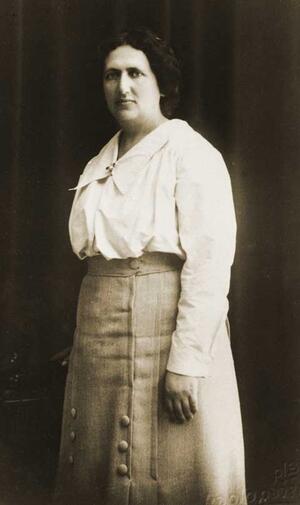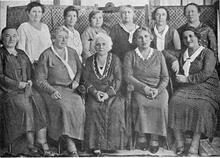Sarah Thon
Sarah Thon was born in Lvov, Galicia. She attended a gymnasium, learned arts and crafts, and became a Zionist. She married Yaakov Thon and they settled in Ottoman Palestine in 1907. Thon became the representative of the Women’s Association for Cultural Work in Palestine, established by German Zionist women with the aims of educating girls, raising funds for the establishment of hospitals, training nurses, and combating trafficking in women. Thon's main achievements were the establishment of five workshops for poor girls, where the girls learned arts and crafts and earned some money for producing the various items. She was also influential in the establishment of the girls’ farm at Kinneret. Before her early death from malaria, she was active in the fight for women's suffrage in Mandatory Palestine. She had six children, but only three survived.
“…[O]ne must educate the girls. Education is the key. Education for work, education in the Hebrew language. Education on health and hygiene. Work is not a disgrace!”
Thus wrote Sarah Thon from Tel Aviv in an article that was printed in the autumn of 1910 in the Zionist weekly Die Welt (published in Germany).
Early Years
Sarah Leah Thon was born in Lvov, Galicia, on March 4, 1881. Although her father, Yeshayahu Brat, was a poor man, he made certain that she received a good education, first in private schools and later, as soon as it was established, in the first high-school for girls in Lvov. An excellent pupil, she attracted the attention of her teachers with her talents. Because of her family’s poverty, she began giving private lessons to other pupils in order to contribute to the family income. In Lvov she met her husband Yaakov Thon, became a Zionist, and started to plan her future life there by studying arts and crafts. In 1902, she married Thon but decided to go to Germany on her own in order to qualify in the subject she planned to teach upon going to Palestine. Her husband meanwhile, stayed in Lvov to complete his law degree.
The Establishment of Lace-Making Workshops in Palestine
In conversations with Otto Warburg (1859–1938) (who later became the third head of the World Zionist Organization 1911–1920), Thon reached the conclusion that in Palestine there was a need for girls’ workshops where the pupils would earn money by being taught lace-making. Lace-making was easy and required little capital investment in anything other than needles and thread.
Sarah emigrated to Palestine with her husband and their son Theodor at the end of 1907. Her husband became the deputy of Arthur Ruppin (1876–1943), who headed the Palestine Office in Jaffa, which represented the World Zionist Organization. Sarah became the representative in Palestine of the Women’s Association for Cultural Work in Palestine (Verband des Jüdischer Frauen für Kultur Arbeit in Palästina). This organization was established during the 8th Zionist Congress 1907, in order to promote Jewish women's life in Palestine. Its aims were education for girls, raising funds for the establishment of hospitals, the training of nurses, and combating trafficking in women (prostitution).
At first Sarah worked to support the Sha’arei Zion hospital in Jaffa, acquiring equipment and recruiting trained staff. Yet her most important project was the five workshops for girls that she had established. In 1908 she opened the first workshop for lace-making in Neve Zedek, which was at the time still part of Jaffa. The other four were established in Jerusalem, Tiberias, Safed, and Ekron. Thon hoped to found another one in Damascus with the help of the Baroness Adelaide de Rothschild, the wife of Baron Edmund, but the outbreak of WW1 put an end to her expectations.
Most of the girls employed in the workshops were from poor Sephardi families. The girls were also taught Hebrew. One of the teachers was Shoshana Lishansky, mother of Rahel Yanait Ben-Zvi (1886–1979). In 1914 the number of pupils at the five workshops reached six hundred—a large number, given the difficult conditions that prevailed in the country at the time.
The work was of financial importance. The women’s organization supplied the raw materials, yarn and needles arrived from Germany, and the girls received the materials and sewed the products, which were sold both in Palestine and abroad, especially in Egypt, Germany, Austria, and the Netherlands. They received remuneration according to the amount of goods they produced, and their earnings helped their families, in many of which the father was unemployed. Through a collaboration with Boris Schatz (1867–1932), the founder and head of the Bezalel School of Art, the lace work produced by the girls was displayed in several exhibitions in European capitals and in the United States.
Hadassah Kalvary Rosenblüth (1891 – 1945, later the wife of Pinhas Rosen, Israel’s first Minister of Justice), who headed the Safed workshop wrote:
We rented a spacious, attractive house at the edge of the city. The room, which was large and had a balcony, could hold a hundred pupils. We prepared five long tables, a hundred chairs, a desk, several dozen enamel basins for washing hands, several dozen towels, a cupboard for storing materials, yarn—and the place was set up!
The event was publicized with large posters in the streets of the town, inviting women and girls aged fourteen and over to apply—and they indeed came, most of them [encyclopedia_glossary_term:394]Sephardim[/encyclopedia_glossary_term]. An eye examination revealed that some fifty-seven girls of the one hundred and thirty Sephardi women and girls who reported suffered from trachoma.
Since the girls spoke English, French, Hebrew and Yiddish, we devoted one hour a day to the study of Hebrew and this was also the compulsory language of instruction. Girls who were not clean were sent home.
At first, there were disputes with the girls; we asked them to buy aprons and they refused and some of them went back to the mission school because there nobody insisted on cleanliness. Finally, just before [encyclopedia_glossary_term:322]Hanukkah[/encyclopedia_glossary_term], there was a room full of clean girls, shining in their white aprons. Then they started to be meticulous about cleanliness and people in the town learned to recognize the pupils of the lace-making school.
Establishment of the Kinneret Girls’ Farm
In 1911 Sarah Thon helped the Palestine Office establish an agricultural training farm for girls next to the boys training farm at Kinneret. Thus, the Women’s Association for Cultural Work in Palestine added another project to its organization. The girls’ farm was initiated by the agronomist Dr. Hannah Maisel (1883 – 1972) and became a very famous institution.
The Kinneret Girl's Farm, which also trained the girls in home economics, took up a great deal of Sarah’s time and energy, since she frequently had to make the long journey between Tel Aviv and Kinneret. Since there was as yet no railway connection, one had to travel by horse and carriage to Haifa, where a railroad ran to Zemah. From there, a boat took one across Lake Kinneret to the farm. Thon invited some famous tourists to this farm, including Baroness Adelaide de Rothschild.
An interesting dispute between Sarah Thon and the group of young women at Kinneret began with an article by Sarah Thon entitled “On the Topic of Women Agricultural Workers,” which appeared in Ha-Po’el ha-Za’ir on March 14, 1913. In it, she criticized the girls for failing to keep their rooms clean, and for dressing like men. A woman has the same rights as a man, she argued, but she also has special duties. “Out of their desire to resemble men in every respect, they cease to pay attention to their appearance, cut their hair short, and try to divest themselves of the mystical charm which is spread on the face of every young woman. Though these external factors are no proof of negative symptoms, one can discern in them a psychological inclination and a special view of life.” Thon was a liberated woman, but she held firmly to the notion that women should adhere to their femininity.
The women workers responded in Ha-Po’el ha-Za’ir of April 14, 1913: “First of all, we want to point out to Mrs. Thon that our views on the value of work in the fields differ as greatly from hers as East from West. Like the male workers, we seek first and foremost to heal our bodies and our spirit and to achieve through work the freedom, the beauty and wholeness of soul that Mrs. Thon refers to.… In our eyes these are not merely the means to create an agricultural class in our land.”
Involvement in the Yishuv in Jerusalem
In April 1917 the Turks expelled the Jews from Tel Aviv, but permitted Dr. Thon, who was at the time the acting head of the Palestine Office, to move to Jerusalem with his family, rather than to the north of the country. Immediately after the British conquest of Jerusalem on December 9, 1917, the leaders of the [encyclopedia_glossary-term:432]Yishuv[/encyclopedia_glossary_term] founded the “Provisional Committee,” whose function was to prepare the Yishuv for democratic elections. Sarah Thon was instrumental in establishing the Union of Hebrew Women for Equal Rights in Erez Israel, a militant body which demanded full equal rights for women, especially the right to vote and to be elected to the Yishuv institutions. Eventually elected to the Provisional Committee as a representative of the Federation, when she was well she traveled throughout the country on behalf of the organization, giving public speeches and urging women to fight for their rights.
As head of the Provisional Committee, her husband wished to establish a “Founding Assembly,” based on democratic elections throughout the entire country, but the establishment was postponed numerous times as a result of disputes between the religious and non-religious sectors. Sarah Thon died on April 19, 1920, before the elections were held. Women won full rights of representation only in January 1926 after a long struggle with the Orthodox.
Personal Life
Sarah Thon dedicated her entire short life to public works. Although she felt (as she frequently expressed in writing) that she was neglecting her children and not giving them the care, education, and love they deserved, she never gave up her work for society at large.
She bore six children: in 1903 Baruch, who died after a few months; Theodor (1905–1978); Rachel (1908–1911) was three years old when she died; Judith (1909–1997); Raphael (1916–2005); and Aviva was one year old when she died (March 1917–May 1918).
Sarah Thon lived a hard life, at a difficult time. Never a healthy woman, she experienced considerable suffering. At the time of her death on March 12, 1920, she was survived by only three of her six children.
Shilo, Margalit. Girls of Liberty: The Struggle for Suffrage in Mandatory Palestine. Waltham, MA: Brandeis University Press, 2016.
Thon, Raphael. The Fight for Women’s Rights: The Life Story of Sarah Thon. Israel: Private publication, 1996. (Hebrew)





